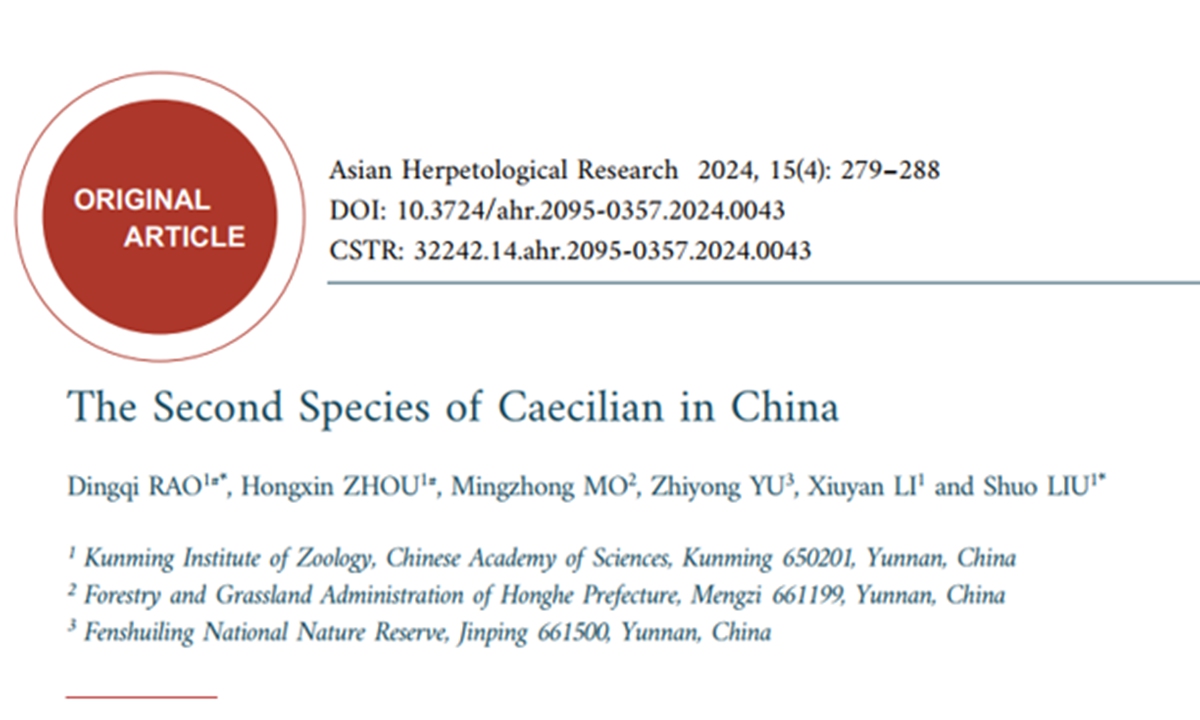
Photo: Courtesy of the Kunming Institute of Zoology
A new unstriped
Ichthyophiswas found in Southwest China's Yunnan Province,
MKsport the Kunming Institute of Zoology under the Chinese Academy of Sciences announced on Thursday. The new species is named
Ichthyophisyangi. The finding was published in Asian Herpetological Research.
Rao Dingqi, an expert in amphibians and reptiles from the Kunming Institute of Zoology who participated in the research, told the Global Times on Thursday that this is the second species of caecilians found in China, after
Ichthyophisbannanicus, commonly known as the banna caecilian.
"It is an important finding from China's biodiversity survey and increases the number of caecilian species in China from only one to two," Rao told the Global Times.
In the past, there was only one species of caecilian, a snake-like amphibian, recorded in China. Originally reported by Yang Datong in 1976, it was recognized as a new species,
Ichthyophisbannanicus, in 1984. At present, this species is known to be distributed in the provinces of Yunnan and Guangdong and the Guangxi Zhuang Autonomous Region.
Caecilians are limbless burrowing amphibians found in tropical regions of Asia, Africa, and South America. They resemble earthworms, though they are true vertebrates with visible jawbones, which all worms lack. They have circular folds on their skin that make them look segmented and skin covering their eyes, although they can see. Unlike snakes, they have greatly reduced or even absent tails with their anus close to or at the tips of their bodies. Caecilians are predatory and have a well-developed sense of smell.
The Honghe Hani and Yi autonomous prefecture in Southwest China's Yunnan is an area rich in biodiversity. However, the banna caecilian that live along the southern border of Yunnan has never been found in the autonomous prefecture. In 2024, researchers discovered caecilians in the prefecture's Jinping county, but found they are completely different from banna caecilians.
In 2023, a group of local residents in Jinping county found a dead and partially dried caecilian beside a road near a village, which they took to researcher Mo Mingzhong. He then took it to the Kunming Institute of Zoology, where it was recognized as a stripeless
Ichthyophis.
Through further research, it was determined to be a new species of caecilian that had never been discovered before by the research team that included Rao, Mo, Zhou Hongxin and Li Xiuyan. It was named Yang's caecilian or Honghe caecilian in Chinese to pay tribute to Yang Datong, who first discovered the
Ichthyophisspecies in China.
As it lacks the light yellow stripe often seen on other caecilians, Rao noted that it was also the first stripeless
Ichthyophisfound in China.
The discovery also reminded us that "our investigation and understanding of Yunnan's biodiversity is far from thorough, and many species need to be further investigated and discovered," he said.


 Full text: Joint statement between China and Kenya on creating an inspiring example in the all
Full text: Joint statement between China and Kenya on creating an inspiring example in the all MMA fighter Zhang Weili talks about future plan after latest victory
MMA fighter Zhang Weili talks about future plan after latest victory US, Japan urged to stop interfering in China’s internal affairs, Chinese FM on US
US, Japan urged to stop interfering in China’s internal affairs, Chinese FM on US South Korean court issues warrant to extend detention of impeached president Yoon
South Korean court issues warrant to extend detention of impeached president Yoon